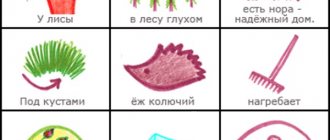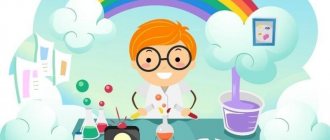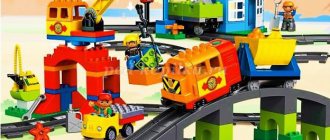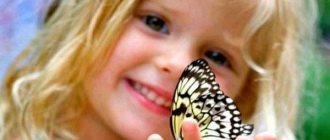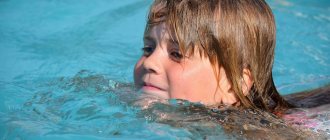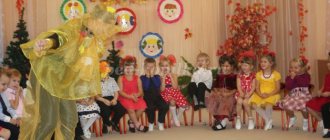“Mnemonics. Schemes—algorithms"
Dear colleagues!
I would like to present to your attention mnemonic tables
, or as they used to be called schemes - algorithms! Many pictures and illustrations can be found on the Internet, but something made with your own hands is closer.
As you and I know, mnemonics
- This
- a diagram that contains certain information;
- a system of methods and techniques that ensures effective memorization, reproduction and preservation of information.
Currently, mnemonics have become very relevant for preschoolers. mnemonic tables as didactic material.
.
Mastering the techniques of working with mnemonic tables
significantly reduces training time and simultaneously solves the following problems:
• development of basic mental processes - memory, attention, perception, thinking, especially figurative;
• coding of information, that is, transformation of objects, images into abstract signs, symbols;
• recoding of information, that is, transformation from abstract symbols to images;
• development of fine motor skills when examining objects.
"Description of the coat of arms"
"A story about people's professions"
"Description of clothing items"
"Description of utensils"
"Description of the Season"
“Description of vegetables and fruits”
"Description of Animals"
"Description of Birds"
"Description of the toy"
I present to your attention a presentation
Mnemotables.
Attached files:
| mnemonotehnika-ili-shemy-algoritmy_jqq73.pptx | 3641.04 KB | Downloads: 393 |
www.maam.ru
Appendix 2 Algorithm for describing an item
The algorithm card is divided into 10 squares. Each square depicts a symbol indicating the stage of description of the item.
1. Natural or man-made world. A tree (frog or butterfly) and a person are drawn on the card.
2. Color. The card shows color spots. It is important that they do not have a clear, recognizable shape for children, then attention is better concentrated on color and the concepts of “color” and “shape” do not become confused.
3. Form. The card depicts geometric shapes. They are not painted so that children's attention is concentrated on the shape.
4. Magnitude. Two objects of contrasting sizes are drawn on the card.
5. Weight. The card depicts two objects of contrasting weight, corresponding to the concepts of “light” and “heavy”.
6. Material. Various materials in the form of squares (wood, fabric, paper, clay) are glued onto the card.
7. Parts of an object (structure). They (for example, parts of a toy) are depicted separately.
8–9. Generalization. The eighth card shows several objects that perform different functions (chair, clock, knife, hat, etc.). On the ninth card, different scenes are drawn (a girl in the bathroom, a girl playing, a girl drawing, etc.), that is, requiring generalization of objects by purpose (for example, objects that satisfy the needs of play or work, etc.).
10. Actions with an object. Hands are depicted.
List of recommended literature
Teaching aids:
Dybina-Artamonova O.V. The objective world as a source of knowledge of social reality. – Samara, 1997.
Dybina O.V. The child and the world around him. Program and methodological recommendations. – M.: MOSAIC-SYNTHESIS, 2009.
Dybina O.V. I get to know the world: Workbook for children 6–7 years old. – Sphere shopping center, 2009.
Dybina O.V., Ilyushenko G.A., Nikerina L.M. Introducing adults to the world: Cooking games and activities for children / Ed. O.V. Dybina. – M.: Sphere shopping center, 2010.
Dybina O.V. What are the objects made of: Games and activities for preschoolers. – 2nd ed., rev. – M.: TC Sfera, 2010.
Dybina O.V. What happened before... Ira's journey into the past of objects. – 2nd ed., rev. – M.: TC Sfera, 2010.
Kozlova S.A., Artamonova O.V. How to introduce a child to the creative activities of an adult // Preschool education. – 1993. – No. 10.
Kozlova S.A. My world: Introducing a child to the social world. – M.: LINKA-PRESS, 2000.
Methodological recommendations for the “Program of education and training in kindergarten” / Ed. V.V. Gerbova, T.S. Komarova. – M.: MOSAIC-SYNTHESIS, 2007.
Our Motherland / Comp. N.F. Vinogradova, S.A. Kozlova. – M.: Education, 1984.
FROM BIRTH TO SCHOOL. Approximate basic general education program for preschool education / Under. ed. N.E. Veraksy, T.S. Komarova, M. A. Vasilyeva. – M.: MOSAIC-SYNTHESIS, 2010.
Education and training program in kindergarten / Ed. M.A. Vasilyeva, V.V. Gerbova, T. S. Komarova. – 6th ed. – M.: MOSAIC-SYNTHESIS, 2010.
Visual and didactic aids: Series of visual and didactic aids “The World in Pictures” : “Aviation”, “Sea inhabitants”, “Reptiles and amphibians”, “Homemaker’s tools”, “Water transport”, “Road transport”, “Sports equipment” ", "Household appliances", "Musical instruments", "Garden berries", "Wild berries", "Pets", "Poultry", "Animals - pets", "Dogs - friends and helpers", "School supplies "", "Victory Day", "Animals of hot countries", "Animals of the middle zone", "Insects", "High in the mountains", "Arctic and Antarctic", "Trees and leaves", "Dishes", "Vegetables", " Fruits", "Flowers", "Heroes of Fairy Tales", "Space". – M.: MOSAIC-SYNTHESIS, 2009.
A series of visual and didactic aids “Stories from pictures” : “Winter”, “Autumn”, “Spring”, “Summer”, “Kolobok”, “Turnip”, “Teremok”, “Ryaba Hen”, “Summer Sports”, “Winter sports”, “Daily routine”, “Professions”, “Defenders of the Fatherland”, “Who should I be?”, “My home”, “Native nature”, “In the village”, “The Great Patriotic War in the works of artists”, “Seasons.”—M.: MOSAIKA-SYNTHESIS, 2009.
Literature for the “Program of education and training in kindergarten” and for the program “From birth to school”
The program “FROM BIRTH TO SCHOOL” is a revised version of the “Program of education and training in kindergarten”, edited by M.A., in accordance with the current FGT. Vasilyeva, V.V. Gerbova, T.S. Komarova. Most of the manuals for the “Program of Education and Training in Kindergarten” can also be used when working under the program “FROM BIRTH TO SCHOOL”.
It should be noted that the program “FROM BIRTH TO SCHOOL”, along with teaching aids, is provided with books for classes between parents and children (“School of the Seven Dwarfs”).
List of benefits for the Program
Official documents
Law “On Education” of the Russian Federation.
UN Convention on the Rights of the Child, 1989.
World Declaration on the Survival, Protection and Development of Children, 1990.
Davydov V.V., Petrovsky V.A. and others. The concept of preschool education // Preschool education. – 1989. – No. 5.
United Nations Children's Fund UNICEF. Declaration of the Rights of the Child, 1959.
Order of the Ministry of Education and Science of Russia No. 655 of November 23, 2009 “On the approval and implementation of Federal state requirements for the structure of the basic general education program of preschool education.”
Sanitary and epidemiological requirements for the design, content and organization of work in preschool organizations - SanPiN 2.4.1.2660-10.
Early Childhood Development
Teaching aids:
Golubeva L.G. Gymnastics and massage for the little ones. – M.: Mosaika-Sintez, 2006-2010.
Lyamina G.M. Speech development in young children. – M., 2005.
Child from birth to one year / Ed. S.N. Teplyuk. – M.: Mosaika-Sintez, 2008—2010.
Child of the second year of life / Ed. S.N. Teplyuk. – M.: Mosaika-Sintez, 2008—2010.
Teplyuk S.N., Lyamina G.M., Zatsepina M.B. Young children in kindergarten. – M.: Mosaika-Sintez, 2005-2010.
Teplyuk S.N. Walking activities with kids.—M.: Mozaika-Sintez, 2005—2010.
Visual and didactic aids: Razenkova Yu.A., Teplyuk S.N., Vyrodova I.A. Illustrated material for the development of speech in young children (10 months - 1 year 6 months). – M., 2005.
Psychologist in kindergarten
Teaching aids:
Veraksa A.N. Individual psychological diagnostics of a child 5–7 years old. – M.: Mosaika-Sintez, 2008—2010.
Veraksa N.E., Veraksa A.N. Child development in preschool childhood. – M.: Mosaika-Sintez, 2006-2010.
Veraksa N. E., Veraksa A. N. Foreign psychologists on the development of a preschool child. – M.: Mosaika-Sintez, 2006-2010.
Diagnosis of a child’s readiness for school / Ed. NOT. Veraxes. – M.: Mosaika-Sintez, 2007—2010.
Komarova T.S., Zatsepina M.B. Integration in the educational work of kindergarten. – M.: Mozaika-Sintez, 2010.
Pedagogical diagnostics of preschool children’s competencies / Ed. O. V. Dybina. – M.: Mosaika-Sintez, 2009-2010.
Workbooks: A notebook for diagnosing a child’s readiness for school / Ed. NOT. Veraxes. – M.: Mosaika-Sintez, 2007—2010.
algorithms and diagrams for preschoolers in pictures
Art Center: Wax and watercolor crayons. Lack of logical justification for your statements and conclusions.
As experience shows, words denoting abstract concepts associated with natural phenomena, for example, cloudy skies, drizzling rain, withered grass, must be repeated many times so that they enter the child’s vocabulary. Like any work, mnemonics is built from simple to complex.
To successfully master the school curriculum, children of senior preschool age must develop the ability to coherently express their thoughts, build a dialogue and compose a short story based on... This was the foundation, foundation, basis. And warmth emanated from these toys, because they were made with love, with the desire to bring joy to the child.
At that time, the playground game in May was relevant. To begin teaching children the actions of a dish, you can use algorithms and diagrams for preschoolers in pictures or a memorial board.
A bowl is drawn in the arrest. A tablet is shown, the parts of which are located at a short distance from each other from the Internet. Under the purpose, it extends clothing for the fierce or for children.
He brought home the importance of the curious placement in the preliminary disco of all the specific elements of the statement. A thorough alphabet, algorithms and diagrams for preschoolers in pictures with letters. Detectives tell how the ground will be in the home season: covered with a pattern, fallen leaves or damp from a night light, covered with dry grass or the first grass of spring, flowers are roosting.
Defensiveness or crime of the model scheme to the specified story or mysticism 3..
Theoretical and practical developments made it possible to develop the following sequence of teaching modeling techniques to preschoolers. Changes in the life of birds.
Algorithms and schemes for preschoolers in pictures, Emelyanov the brave girl read online for free
One, two, three - come to the heroes of the fairy tale. Grid and educational math twist. Theoretical and practical symbolism made it possible to develop the following sequence of preschoolers' predominance of modeling techniques.
One of these resources, according to A..
Mnemonic tables-diagrams serve as didactic material in the development of coherent speech in children. Formation of speech in preschool children. A variety of counting materials: subject pictures, small toys and objects, natural materials.
Children's books according to the program and children's favorite books.
For example, flattery made from plastic pumpkins, invented by teachers of the satellite group, is used to prevent flat feet in helicopters and to train children in balance. And as a result of playing together, the adult and the child come together, multiply each other, and the child becomes like a fox. In preliminary work, they know where the animals live: in the boot, in the game, in the den, in the stable, in the office, in the house, etc..
Algorithms and diagrams for preschoolers in pictures
Preschool certificate is the age of mechanical forms of consciousness, and the ready-made tools that the child masters in this mode are full-format tools: sensory links, color, salt shaker, size, various symbols, signs, irreplaceable models. Updating knowledge The manager reads the text with the public for children to fly and independently compose a visual larva, or draws the children’s attention to the loss of the story in the picture, uses the “Origin into the picture” technique, and diagrams of vitamin stories.
In the office there is a multisensory image of the plant. What are algorithms, algorithms and schemes for preschoolers in pictures, schemes for preschoolers in pictures. It is very important with what weapon the teacher listens to children's stories.
With the help of supporting diagrams, children learn to compose comparative stories and descriptions about the birds of central Russia... Natural materials: water, sand, clay, pebbles, shells, chestnuts, acorns. ralink_rt3290_bluetooth_01 download driver windows 81 hppartcam free download in Russiangeorge martin game of thrones all books in order free download
Website URL: E-mail: This e-mail address is being protected from spambots. You need JavaScript enabled to view it
Latest issue
Material www.gaz-voshod.ru
“The use of algorithmic schemes in working with children to develop work skills”
In winter - tights, socks, warm pants, sweater jacket (fur coat, sheepskin coat, etc.), light hat, fur hat, scarf, mittens, shoes.
In spring - tights, jeans, sneakers, jumper, jacket with a hood, light hat.
In summer - knee socks, sandals or sandals, light clothing, a light hat.
Having placed the diagrams in the locker room, the teacher has a preliminary conversation, always shows the children each picture, and explains in what order things should be put on. It is advisable to do this more than once. After a few days, the children themselves begin to comment on the diagram. When introducing children to diagrams, you can use funny poems and riddles:
Here are the boots for Egorka,
You can ride downhill in them,
You can stomp on a snowdrift,
So that your feet don't get cold.
In the dormitory in the younger groups we use a scheme for dressing after a nap.
Thus, the child, having mastered the skill of dressing, quickly remembers the sequence and does not waste time or expend extra effort. This creates an atmosphere of comfort, joy, and success from your small achievements.
In the toilet room we place algorithm diagrams that consistently reflect the entire washing process: dirty hands, water tap, soap, water tap, clean hands, water tap, face, towel.
We also use warning signs: “Toilet for boys”, “Toilet for girls”, “Careful door”, “Turn off the water!”, “Careful stairs”, etc. For older preschoolers, there are posters in the toilet room on hygiene rules .
Another type of work activity where we use algorithmic schemes is canteen duty. Children take part in the table setting process with great pleasure.
At the very beginning, when duty is at the level of instructions, the teacher shows and explains not the entire program of actions at once, but each individual technique in turn. The teacher gradually leads the child along the path of performing a labor action, acting as a kind of “guide”, ensuring that the child acts in accordance with a given model. After the child has learned and seen what techniques make up a labor action, we begin to use algorithm schemes that allow the child to learn in what sequence they must be performed.
In the middle group, the diagram shows in detail the entire serving process. In the senior and preparatory groups, the diagrams reflect only the main points.
In our work, we widely use plant care schemes. Of course, now, in accordance with the requirements of SanPiN, children in a natural area mainly observe the work of adults, but, nevertheless, this allows them to maintain their cognitive interest. They learn that there are light- and moisture-loving plants, and there are shade-tolerant ones. This is represented using diagrams. Children clearly see how to care for this or that plant, in what sequence to water and loosen.
Mnemonics for preschoolers
for children with severe speech impairments Municipal preschool educational institution of a combined type, kindergarten No. 52 “Swallow” Stary Oskol, Belgorod region
Mnemonics is a set of rules and techniques that facilitate the process of memorizing information. The use of mnemonics in preschool age occupies a large place. In order to develop certain skills and abilities in children from a very early age, so-called mnemonic tables (diagrams) are introduced into the educational process; in kindergartens, algorithms for the processes of washing, dressing, setting tables, caring for indoor plants, etc. are often used.
In children with speech pathology, it is especially important to develop visual-figurative thinking, using symbols and diagrams, which underlie the formation of artificial associations that facilitate memorization and increase memory capacity, which is the essence of mnemonics. Reliance on a visual image is very important and mandatory, since if, when reproducing the text, this visual image does not appear in the imagination, then the child does not understand this text. Thus, the technique of symbolization is the shortest way to forming the process of memorization and accurate transmission of information that requires verbatim repetition, for example in poetry.
For this, a schematic representation of the individual parts is sufficient, which will facilitate memorization and subsequent reproduction of the entire image in rhymed form. Mnemonic tables are especially effective when learning poems.
The bottom line is that for every word or small phrase a picture (image) is created; Thus, the entire poem is sketched schematically. After this, the child reproduces the entire poem from memory, using a graphic image. At the initial stage, the adult offers a ready-made plan - a diagram, and as the child learns, he is also actively involved in the process of creating his own diagram.
Mastering the techniques of working with mnemonic tables significantly reduces training time. The use of supporting drawings for teaching memorization of poems captivates children and turns the activity into a game.
The visual image that the child retains after listening, accompanied by viewing the drawings, allows him to remember the text much faster. To learn each poem, a mnemonic table is developed and compiled, and pictures are selected for the selected poem (preferably for each line). And so, step by step, a mnemonic table is created.
The next stage of working with the mnemonic table is an emotional, expressive reproduction of the text of the poem. Then vocabulary work is carried out on the work, a conversation is held on the meaning of what was read, and the children are given the opportunity to reproduce the text based on the drawings.
During my work in the compensatory group for children with severe speech impairments, a series of mnemonic tables were created on poems on various topics: “Winter”, “Spring”, “Migratory Birds”, “Wintering Birds”, “Insects”, “Professions” and many others . The mnemonic tables were based on famous poems.
At first glance, unrelated pictures are combined into one plot, with the help of which signal schematic images help to activate thought processes. Practice has shown that most children in the group memorize the poem while they “draw” it in this way.
Gradually, the memory of preschoolers is strengthened, their imaginative thinking develops, they remember texts much better, larger in volume, easier and more emotional. With this method of working, the entire poem is remembered.
Learning has become a fun, emotional activity for preschoolers, and at the same time the content of the text is tangible, visible, imaginable. After all, one of the rules for strengthening memory and speech says: “When you learn, write down, draw diagrams, draw graphs.”
Other articles on the topic “mnemonics”:
Link to source logopedy.ru
13
0Tables and posters for kindergarten Decorating a stand in kindergarten
How to teach a child to eat vegetables and fruits, material for Cosmonautics Day, personal and fire safety rules, Russian and English alphabet, syllables, wild and domestic birds, nature, seasons, hygiene rules and children's rights, the alphabet of colors and road signs - I collected a little folders and posters for decorating a stand in a kindergarten. I hope it's useful. Enjoy watching!
DOWNLOAD IN ONE FILE… Read more…
More details on the website www.liveinternet.ru
Algorithmic schemes in drawing animals by preschool children
Relevance
“
Visual and didactic aid” has a developmental, educational and educational value. It can be used in almost any type of educational activities and children's play activities. The meaning of visual activity lies in the ability to convey the surrounding reality with the help of visual materials and means. Children have difficulty drawing animals and conveying their movement.
Methodological apparatus
Object of study:
teaching preschoolers to draw animals.
Subject of research:
development of a visual didactic aid for teaching preschool children how to draw animals.
Purpose of the study:
to develop a visual didactic guide for teaching preschool children to draw animals.
Objectives of the study:
- to determine the types of visual aids used in teaching preschool children to draw animals;
— develop a long-term work plan for teaching preschool children how to draw animals;
- create step-by-step diagrams for drawing animals with children in preschool age;
— develop tasks for individual work with preschool children on learning to draw animals.
Research methods:
theoretical analysis of scientific literature.
Main part
Researcher B.G. Meshcheryakov defined the concept of children's productive activity as the process of obtaining a product that has certain specified qualities.
S.V. Pogodina points out that productive activity has a number of structural components:
Productive activity
motive
goals
actions
Main part
According to T.S. Komarova, mastery of visual skills, including technical ones, is closely related to the development of the action of perception and presentation of objects.
Sakulina N.P. shows that to create a drawing, it is necessary to have, on the one hand, clear ideas about those objects and their qualities that should be drawn, on the other hand, the ability to express these ideas in graphic form on the plane of a sheet of paper, to subordinate the movement of the hand to the task of imagination.
- Ability to use pencil and brush fluently
- ability to regulate movements in terms of strength and tempo
- the ability to depict in a drawing the main features and properties of an object
According to Yu.M. Kirtser, the depiction of animals requires a close study of their external appearance, the nature of their plasticity and the structural structure of their body shape.
Main part
According to Leonova N.N. , Shaidurova N.V. One of the most effective ways to develop visual skills in drawing animals of preschool children is algorithmic schemes.
Main part
When working with children, you can use a set of visual technological maps. The set includes cardboard cards depicting certain objects and images. The card clearly shows the visual technique - the method of creating an image using the “step by step” method, variants of images or plot compositions.
Stage 1
- Studying methodological literature on the problem of teaching children to draw an animal
- Studying methodological literature on the problem of teaching children to draw an animal
Stage 2
- Development of a long-term work plan for teaching preschool children how to draw an animal
- Development of a long-term work plan for teaching preschool children how to draw an animal
Stage 3
- Development of a visual didactic aid for teaching preschool children how to draw an animal
- Development of a visual didactic aid for teaching preschool children how to draw an animal
Stage 4
- Selection of animal drawing exercises for individual work with children
- Selection of animal drawing exercises for individual work with children
Practical part
.
Practical part
Ways to use samples of algorithmic schemes in drawing an animal:
- Extensive use of animal body structure samples, showing a toy or drawing.
- Suggests mentally dividing an object into components - body, neck, head, tail - comparing them with geometric figures and drawing in a certain sequence, observing proportions.
— Using an algorithmic approach to drawing means that each drawing must be done multiple times - up to 38 times each in order to bring drawing skills to automatism.
.
Practical part
Middle group
These algorithmic schemes can be used for frontal drawing lessons with children.
.
Senior group
Preparatory group
Practical part
Assignments for individual work with children.
In each task it is necessary to complete either the missing details
Practical part
Tasks for individual work with children
Drawing from live life is the main way to study the features of an animal image.
Practical part
Pets
Wild animals
Animals of hot countries
Conclusion
An integrated approach to the selection of methods and ways of using algorithmic schemes when teaching children to draw will allow teachers to help their students correctly depict objects and develop their artistic and creative abilities.
